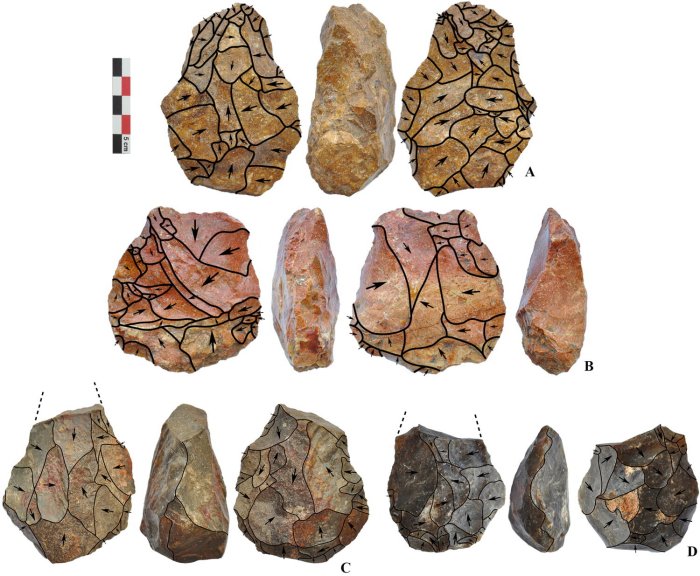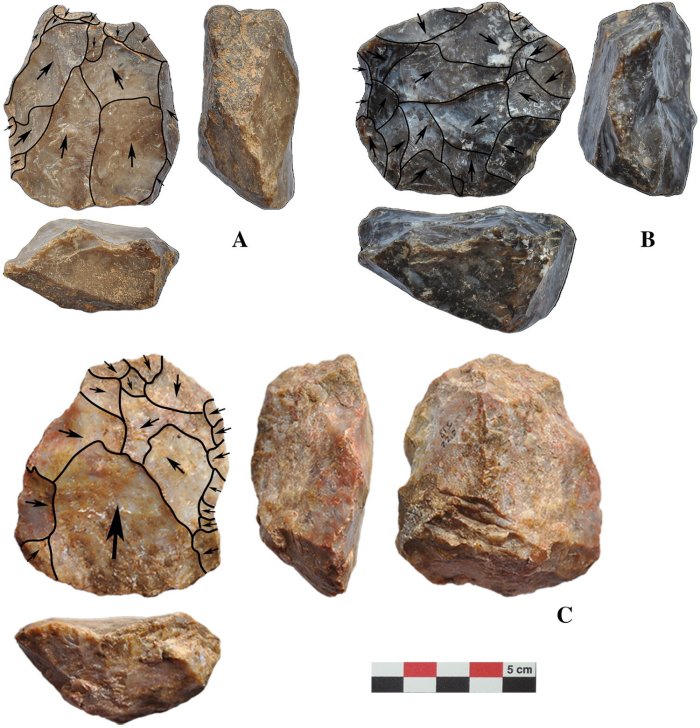Conny Waters – AncientPages.com – Landmasses that are now submerged may have eased the crossing of early humans between present-day Turkiye and Europe, a new study reveals.
Located on the northeastern Aegean coast, Ayvalik occasionally became dry land during the Pleistocene, allowing early human occupation. This study explores its Paleolithic potential in western Anatolia, often overlooked in Pleistocene archaeology, and presents initial findings.
Large cutting tools. A handaxe from Şirinkent I (A); A cleaver from Şirinkent I (B); Handaxes with broken distal ends from Sahilkent (C and D). Source
The findings reveal a previously undocumented Paleolithic presence in Ayvalik and may redefine our species’ migration into the continent.
Homo sapiens were originally believed to have entered Europe mainly via the Balkans and Levant. However, 138 lithic artifacts identified by survey at 10 sites across a 200km² area suggest the northeastern Aegean coast of Ayvalik (now in Turkiye) was another route for early humans.
“Our archaeological discovery has unveiled that this now-idyllic region once potentially offered a vital land bridge for human movement during the Pleistocene era—when sea levels dropped and the now-submerged landscape was briefly exposed,” explains Dr Göknur Karahan, from the Department of Archaeology-Prehistory, at Hacettepe University, in Turkiye, who was part of a fully female team of expert archaeologists from the country.
Researchers suggest Ayvalik could be a new frontier in human evolution, marking its significance in prehistory and possibly showing how early humans entered Europe. During the Ice Age, sea levels dropped over 100 meters, revealing coastal plains now underwater. Ayvalık’s islands and peninsulas were then part of a landmass connecting Anatolia and Europe.
General view of selected Paleolithic findspots identified during the Ayvalık survey. Atatürk Koruluğu (A); Eski Altınova Yolu (B); Tuz Gölü II (C); Tuz Gölü I (D); Sahilkent (E); Hakkı Bey Yarımadası (F). The images reflect the diverse environmental settings of the survey area, including pine forests, olive groves, and coastal scrublands. Source
The tools uncovered in this recent discovery are located along the modern coastline, providing evidence of human habitation and movement across these now-submerged landscapes. Previously, factors such as environmental processes and the depth of deposits have posed challenges to detecting and preserving remains in Ayvalik.
Co-author Professor Kadriye Özçelik from Ankara University explains that during various historical periods, the current islands and peninsulas of Ayvalik would have been interior areas within a vast land environment. These paleogeographic reconstructions highlight the region’s significance in studying
Early humans’ movements across the northeastern Aegean during the Pleistocene era.
The region’s changing geology and active coastlines in the North Aegean made preservation difficult, limiting the number of uncovered items. However, the research team found Levallois technologies from various Paleolithic periods, including handaxes and cleavers.
Notable finds include Levallois-style flake tools, linked to the Middle Paleolithic Mousterian tradition, which is often associated with Neanderthals and early Homo sapiens.
Cores. Levallois cores from Sahilkent (A and B); Levallois core from Şirinkent II (C). Source
Dr. Karahan explains that these large cutting tools are some of the most iconic artifacts from the Paleolithic era and remain easily recognizable today, making them a significant discovery. The presence of these objects in Ayvalik is especially noteworthy because they offer direct evidence that this region was part of broader technological traditions shared across Africa, Asia, and Europe.
According to experts, Ayvalik represented a key site for interaction and exchange, and linked the Anatolia peninsula and Europe during glacial sea-level lows. It contributed with alternative pathways for early human movement beyond northern mainland routes. Ayvalik was a mobility corridor for the movement of Early humans.
And as Dr. Hande Bulut from Düzce University states: “the results of the study,highlight Ayvalik’s potential as a long-term hominin habitat and a key area for understanding Paleolithic technology in the eastern Aegean. Preliminary findings emphasize the region’s role in debates on Aegean connectivity and technological evolution during the Pleistocene. Despite geomorphological challenges, it may still reveal valuable clues to early occupation.”
Written by Conny Waters – AncientPages.com Staff Writer




